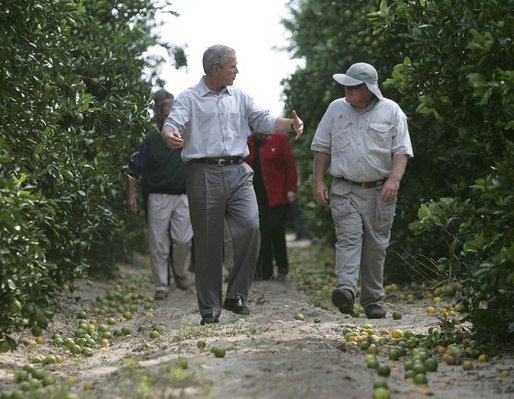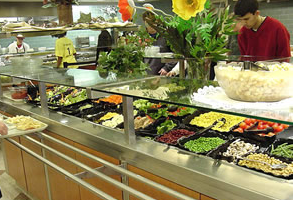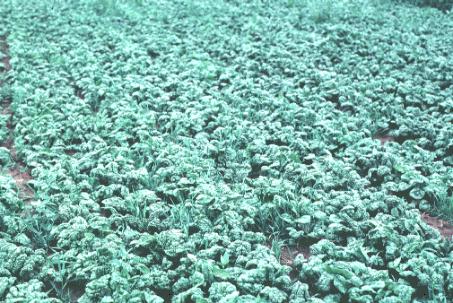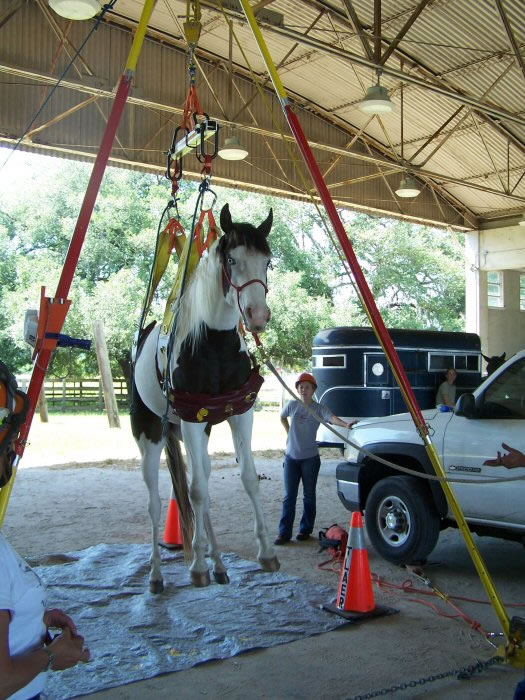Deadline Looms for 2005 Hurricane Assistance
|
Florida farmers and ranchers have until Friday, September 29th to apply for four 2005 hurricane disaster programs, according to Kevin Kelley, State Executive Director of the Farm Service Agency (FSA). The programs provide aid to producers who suffered losses due to 2005 hurricane destruction.
"I certainly encourage all producers to contact their local FSA office to enroll in these programs before the deadline",Kelley says. "By law, no late-filing is allowed".
The four programs provide payments to eligible producers due to the hurricanes:
- Livestock Indemnity: who incurred the death of livestock.
- Feed Indemnity: who suffered feed losses or increased feed costs.
- Hurricane Indemnity: who suffered crop losses and received either a Federal Crop Insurance Corporation crop insurance indemnity or an FSA Noninsured Crop Disaster Assistance payment. (All producers who either filed a claim with a re-insurance company or received an indemnity must contact their county FSA by September 29!)
- Tree Indemnity: who suffered losses of commercially grown fruit or nut trees, bushes or vines that produce an annual crop.
To be eligible for this assistance, a producer’s loss must have occurred in one of the 261 counties that received a primary presidential or secretarial disaster designation due to 2005 hurricanes Dennis, Katrina, Ophelia, Rita or Wilma. A map of eligible counties is available at http://www.usda.gov/img/content/hurr2005_SEC-PRES_Primary.jpg. A fact sheet with detailed program information is available at http://www.usda.gov/2006/01/0027.xml.
USDA has also made other programs available. Interested producers should contact their local USDA Service Center for information.
For additional information go to http://disaster.fsa.usda.gov.

President George W. Bush walks with Pat McKenna through a hurricane-battered orange grove in Lake Wales, Florida, Wednesday, September 29, 2004. Located in the heart of Florida's citrus country, almost half of the McKenna brothers' orange grove was destroyed by hurricanes.
|
[top]
Spinach Emergency Not Yet in Florida
Popeye would be profoundly puzzled.
Normally, infections from E. Coli bacteria are spread through under-cooked ground beef and, while it is always serious, the infection is rarely deadly.
The current E. coli emergency in the U.S. is quite different. Bacteria on spinach are apparently spreading it.
According to the Centers for Disease Control and Prevention, at least 131 infections have now been documented in 21 states. The outbreak is not localized; cases have been treated from Connecticut to Oregon, Minnesota to New Mexico. So far, of the 131 E. coli cases linked to spinach, 66 individuals have been hospitalized, 20 have suffered kidney failure and one Wisconsin woman has died.
"At this time, there have been no reports of illness in Florida from this product," says Bill Veach, director of the Division of Hotels and Restaurants in Florida’s Department of Business and Professional Regulation. The only safe approach to spinach at this moment is to avoid all fresh spinach and foods containing fresh spinach.
Veach’s division is responsible for licensing, inspecting and regulating public lodging and food service and has withdrawn from commerce several packaged spinach products from Salinas, California: “Natural Selection Foods?and “River Ranch Fresh Foods.?br>
Although spinach is a very minor crop in Florida, some is grown in Orange County and is normally available during March and April.
The “E. coli?bacteria associated with the current emergency causes bloody diarrhea and abdominal cramps. In severe cases ?called Hemolytic uremic syndrome ?E. coli (or Escherichia coli 0157.H7) kills red blood cells, causes kidney failure and death in 3-5% of the cases which receive good care. (E. coli can be killed by cooking at 160 degrees F. for 15 seconds, but hands and counter tops or a sink that contacts the pre-cooked spinach can become contaminated.)
This vegetable-related emergency, while profoundly sad for those who have become sick as a result, may have a tiny silver lining. Because researchers in the various states and at the federal level have so far been unsuccessful identifying the source of contamination, it highlights the vulnerability of our food supply to potential eco-terrorists.
For additional information please visit www.cdc.gov.

Salad bars usually contain
spinach |

A spinach field in central Florida |
|
[top]
Powerful Earthquake Stirs Gulf: Are More on the Way?
As if hurricanes were not enough!
What were you doing at 9:56 EDT on Sunday morning, September 10th? You may not have felt it, but a magnitude 6.0 earthquake shook up the Gulf of Mexico. Situated about 330 miles southeast of Orlando at a depth of almost 10,000 feet, it was not strong enough to cause a tsunami, but it was the strongest temblor in the mid-Gulf “Cuba Fracture Zone?in 33 years.
Although earthquakes are rare in the U.S. Southeast, says Randy Cox, Associate Professor of Earth Science at the University of Memphis, Tennessee, they should not be dismissed as unthinkable or impossible. A strong quake rattled St. Augustine in 1879; a magnitude 7.3 quake killed 60 people in Charleston, South Carolina in 1886; and on February 10, 2006 a magnitude 5.2 temblor, centered 150 miles south of New Orleans, shook the Gulf’s normally calm waters.
For additional information, visit this web site http://news.nationalgeographic.com/news/2006/09/060911-earthquake.html?source=rss

Position of recent earthquake in the Gulf of Mexico
[top]
Florida Schedules State ESF17/SART Conference
With the ball rolling forward in so many cooperative areas, the Florida Department of Agriculture and Consumer Services, Division of Animal Industry has scheduled an ESF17/SART Conference for May 30-June 1, 2007, at the TradeWinds Island Grand Resort, St. Petersburg Beach (www.tradewindsresort.com).
The conference is scheduled for the beginning of the 2007 hurricane season, timed to take place after the Florida public school year ends so that families may attend. It is anticipated that between 200 and 300 individuals representing every facet of emergency preparedness and disaster readiness-planning will participate.
This state-wide ESF17/SART event should be especially beneficial for county-level SART coordinators and cooperators. There is a full schedule of informational meetings and demonstrations, and you will have plenty of opportunities to meet face-to-face with the people you regularly Email and talk to on the phone, the very people you will work with in case a disaster or emergency affects your area.
Sessions are tentatively scheduled on animal, aquaculture, farm/nursery, terrorism awareness and emergency management issues. Individual sessions on forming a county SART program and using the SART website plus ICS-100 and IS-700 will be held.
With negotiated room rates less than $100.00 per night, the conference is designed to be affordable as well as informative.
The Division of Animal Industry is designated as the lead agency for Emergency Support Function 17 (ESF17), Animal and Agricultural Issues, in the Comprehensive Emergency Management Plan. ESF17 is responsible for coordinating the response of county, state, federal and volunteer agencies in assisting cities and counties in animal and agricultural issues impacted by an emergency or natural disaster.
For updates and additional information, stay tuned to: www.flsart.org.

TradeWinds Grand Island Resort
[top]
Florida VETS Project Attends Veterinary Conference
More than 300 people visited the Florida VETS Project display of trucks and equipment at the annual Florida Veterinary Medical Conference, September 8-10 in Lake Buena Vista, Florida, according to John Haven, Director of the University of Florida College of Veterinary Medicine in Gainesville. VETS, a cooperative effort of the College of Veterinary Medicine, the Florida Department of Agriculture and Consumer Services and the 2,600-member Florida Veterinary Medical Association (FVMA), stands for Veterinary Emergency Treatment Services.
Florida VETS is a special disaster-response unit based at the University of Florida College of Veterinary Medicine, that can help provide veterinary medical care for animals both large and small impacted by a disaster. “It is similar in concept to the U.S. Army’s old-style MASH units,?Haven said.
Immediately following a disaster such as a hurricane, a VETS team in cooperation with private, state and federal agencies, would perform an assessment of needs in an impacted area. The team would assist veterinary hospitals and clinics, support and coordinate aid for private practitioners, and provide basic to moderate levels of animal care when needed.
The VETS Project was begun with generous grants from the FVMA, Humane Society of the United States, American Veterinary Medical Foundation and PetSmart Charities. These grants and others allowed VETS to purchase two ?ton, 4-door diesel crew-cab pick-up trucks and equip them for animal emergency services. The VETS project also received in-kind support from Port-A-Vet, Webster Veterinary Supply and Toshiba. Haven estimates that another $100,000 is needed to reach the VETS goal for disaster assistance supplies and training.
Please check out the Florida VETS Project brochure at the FVMA Internet site http://www.fvma.com/associations/3040/files/071818%20UF%20Donation%20Flyer.pdf.

Practice
makes perfect
[top]
Farm Credit of South Florida Sponsors Emergency Preparedness Summit
On Friday, August 4, Farm Credit Services of South Florida sponsored an Emergency Preparedness Summit in West Palm Beach. Local nursery owners, vegetable packers, horse ranchers, citrus growers, farm credit administrators, University of Florida research staff and members of the state emergency preparedness team attended.
“We sponsored this event so that our members and staff could get together with some of Florida’s agricultural responders,?says Lyn Cacella, vice president of the association. “During the past two years we have had six hurricanes either come through south Florida or brush by close to shore, including Katrina on its way to New Orleans and the Gulf Coast.?br>
According to Cacella, Farm Credit Services believes that there is strength in knowing what resources are available and how to take advantage of them should a hurricane or other disaster affect the agriculturalists in her area.
Farm Credit of South Florida is a member cooperative charged with improving the well being of the rural portions of the eight counties in its territory. Within these counties, citrus, sugar cane, vegetables, nursery operations, dairy, horses and cattle are important economic sectors.
With a loan value of $86 billion, America’s Farm Credit Service works with all plant and animal agricultural issues. Farm Credit of South Florida (with a gross, eight-county loan value of nearly $500 million) assists producers on such issues as citrus canker, hurricane replanting and relief, sugar import issues, crop insurance and, through Florida’s SART Program, all-hazard preparedness.
For a comprehensive understanding of the Farm Credit system and the South Florida region, visit www.farmcreditsfl.com.

Farm Credit Services South Florida helps producers wrestle with unpredictable hurricane seasons and invasive exotics such as lethal yellowing in citrus
[top]
About the SART Sentinel
Editor: Rick Sapp, PhD, Technical Writer, Florida Department of Agriculture & Consumer Services, Division of Animal Industry [rsa5@cox.net]
Associate Editor: Gregory S. Christy, DVM, State ESF-17 Coordinator, Florida Department of Agriculture 7 Consumer Services, Division of Animal Industry [christg@doacs.state.fl.us]
The SART SENTINEL is an E-mail newsletter prepared monthly by Rick Sapp and the staff of the Florida State Agricultural Response Team. Past issues of the Sentinel are archived on the Florida SART Web Site, www.flsart.org.
If you have a story or photo that you would like to have considered for publication in The SART SENTINEL, please contact the Editors.
|
[top]
|


 Printer-Friendly PDF Version
Printer-Friendly PDF Version





